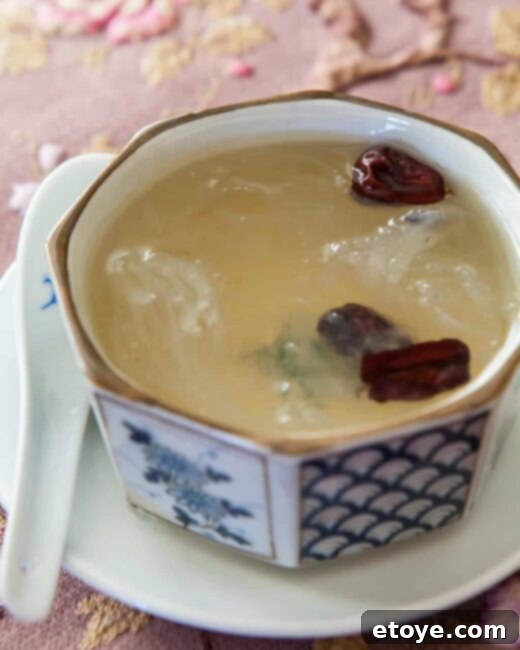Authentic Bird’s Nest Soup: A Culinary Jewel for Special Occasions
Embark on a culinary journey with this exquisite Bird’s Nest Soup, a time-honored Chinese delicacy steeped in tradition and luxury. Prized in Chinese culture for centuries, this soup is reserved for truly special occasions, designed to impress even the most discerning palates. Follow our detailed recipe to craft a soup that is not just a meal, but an experience fit for royalty, offering both delicate flavors and renowned health benefits.
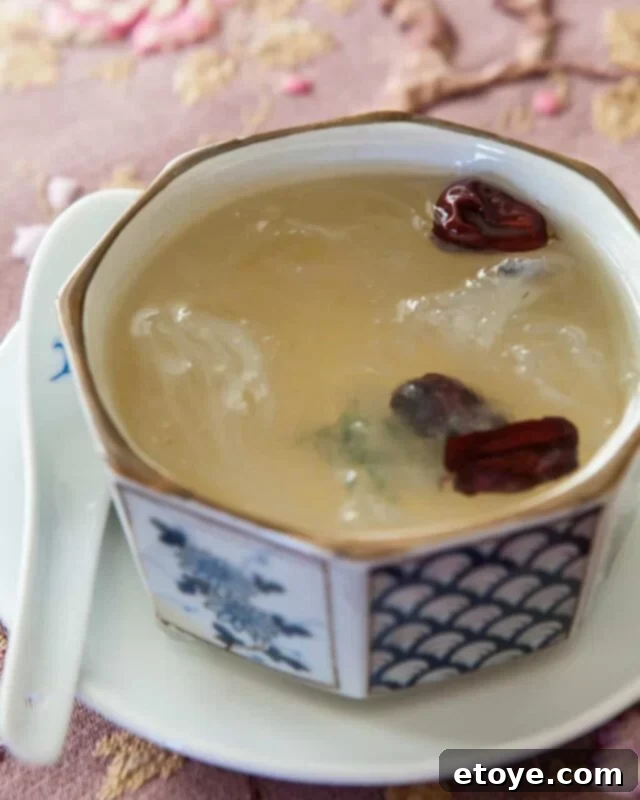
Why This Bird’s Nest Soup Stands Apart
Bird’s Nest Soup is more than just a dish; it’s a testament to ancient culinary artistry and cultural reverence. Our recipe highlights the inherent qualities that make this soup so exceptional:
- A Timeless Chinese Delicacy: With roots tracing back centuries, this soup carries a rich history and cultural weight, signifying prosperity and health.
- Impress Your Guests: The rarity and esteemed status of edible bird’s nest make this soup a showstopper, guaranteeing an unforgettable dining experience for your guests.
- Surprisingly Simple to Master: Despite its luxurious reputation, our recipe breaks down the preparation into clear, manageable steps, allowing you to create this decadent soup with ease.
- Unparalleled Health Benefits: Traditionally cherished for its purported medicinal properties, including boosting immunity and promoting vitality, it’s a nourishing elixir for well-being.
- Delicate Flavor and Unique Texture: Experience the subtle, clean sweetness and the signature gelatinous, slippery texture that defines this cherished soup.
The Elusive Ingredient: Understanding Edible Bird’s Nest
At the heart of this iconic soup lies the edible bird’s nest, a truly remarkable ingredient. These shallow, cup-shaped nests are predominantly built by male swiftlets, specifically species like the Edible-nest Swiftlet, using their solidified saliva. Nest construction is an arduous process, taking these diligent birds over 30 days to complete, typically clinging to the sides of caves or purpose-built structures.
For hundreds of years, Bird’s Nest Soup, known as 燕窝 (yànwō) in Mandarin, has been revered in Chinese medicine and cuisine. Its fame largely stems from its purported health benefits. Traditional beliefs suggest it can enhance complexion, improve digestion, boost the immune system, and even increase libido. While modern scientific research continues to explore these claims, the cultural significance and perceived wellness benefits remain deeply embedded in its appeal. The high price tag, often exceeding $100 per serving in some restaurants, reflects not just its rarity and the labor-intensive harvesting process, but also centuries of tradition, cultural value, and perhaps a touch of mystique and superstition.
Contrary to what one might expect from such an expensive ingredient, the bird’s nest itself possesses very little flavor. Its true allure lies in its unique, gelatinous, and slightly slippery texture, which, when properly prepared, creates a silky and delicate mouthfeel. It is this texture, combined with the subtle sweetness imparted by other ingredients, that makes the soup so memorable and coveted.
Sourcing and Quality: A Critical Consideration
Given the precious nature of edible bird’s nests, their quality and ethical sourcing are paramount. Just as with any highly prized animal product, the industry requires stringent regulation to protect the swiftlet populations. Reputable companies adhere to ethical harvesting practices, waiting for the swiftlets to lay their eggs and for the young birds to hatch and leave the nest before collecting them. This responsible approach ensures the sustainability of the swiftlet species and the continued availability of this delicacy.
There are distinct grades of bird’s nests, each varying in purity, color, and integrity. Lower quality nests, often appearing blackish or containing numerous feathers, require extensive cleaning and may result in a less refined soup. Medium-grade nests, sometimes spongy in appearance, are often used in restaurants where additional ingredients are incorporated to enhance the soup’s profile. For a truly authentic and superior Bird’s Nest Soup, a high-quality, pure nest is essential.
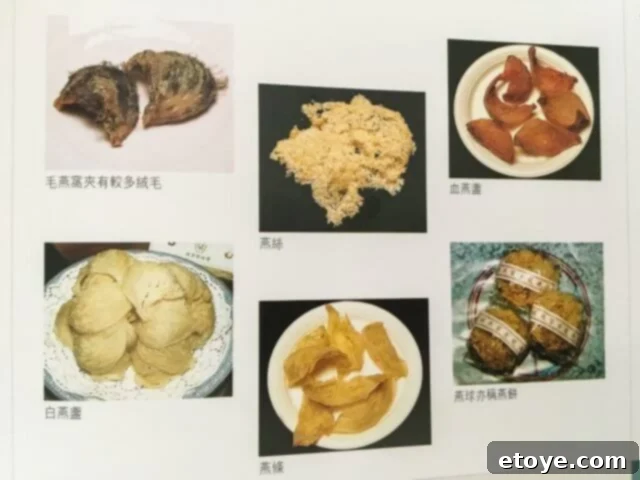
When selecting your bird’s nest, look for products that are perfectly formed, white or pale in color, and visibly free of impurities. We were fortunate to cook with AAA grade bird’s nest from Golden Nest, a U.S.-based company renowned for its premium products. Their nests exemplify the pristine quality desired for this traditional recipe, resembling the ideal examples found in the highest-grade illustrations.
The problem of poachers, illegal harvesting, and illicit exports unfortunately exists in the industry. To ensure you are supporting ethical and sustainable practices, it is crucial to purchase bird’s nests only from reputable companies. Organizations like Golden Nest, which maintains a positive rating with the Better Business Bureau, provide transparency and assurance regarding the origin and quality of their products. This commitment to ethical sourcing not only guarantees a superior ingredient but also contributes to the conservation of these incredible birds.
Essential Ingredients for a Classic Bird’s Nest Soup
For a premium, high-quality bird’s nest, the philosophy is “less is more.” According to the Qing Dynasty manual of gastronomy, the Suiyuan shidan, bird’s nest is a delicate ingredient that should not be flavored or cooked with anything strong-tasting or oily. This preserves its natural subtle essence and exquisite texture. Our recipe embraces this philosophy, using only three core ingredients to allow the bird’s nest to shine:
- Premium Bird’s Nest: The star of the dish, meticulously cleaned and prepared.
- Dried Red Dates (Jujubes): These impart a natural, subtle sweetness and are celebrated for their health benefits.
- Rock Sugar: Provides a clean, delicate sweetness without overpowering the soup’s delicate profile.
- Water: The purest medium to bring all these flavors together.
Spotlight on Dried Red Dates (Jujubes)
Dried jujubes, also known as red dates, are a revered “superfood” in Chinese culture, frequently featured in traditional herbal concoctions, soups, and braised dishes for their remarkable health benefits. These small, wrinkled fruits are packed with nutrients, boasting up to 80 times more Vitamin C than grapes and apples. Traditional Chinese medicine attributes a wide array of benefits to jujubes, including the ability to stimulate the production of white blood cells, thereby enhancing immunity. They are also believed to decrease cholesterol levels in the bloodstream, offering protective benefits for the liver. Their naturally sweet, slightly caramel-like flavor perfectly complements the bird’s nest, adding a layer of wholesome richness without needing artificial sweeteners.
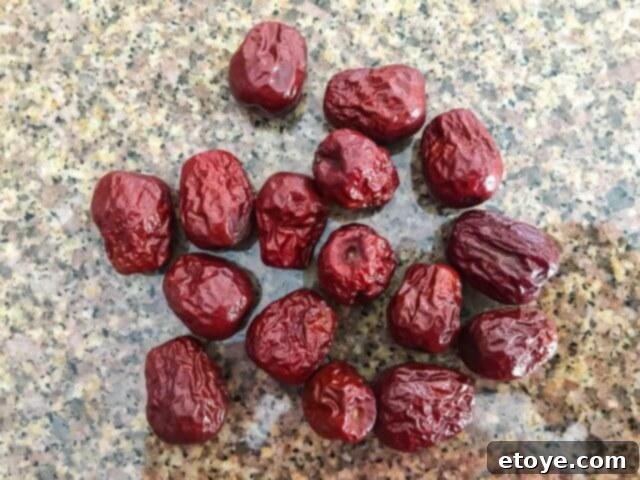
The Role of Rock Sugar
Rock sugar is a cornerstone in many Chinese dessert recipes and savory dishes where a subtle, clean sweetness is desired. Unlike granulated white sugar, rock sugar comes in irregular, golden clumps and is prized for its less intense sweetness. This characteristic makes it ideal for Bird’s Nest Soup, as it sweetens the broth delicately, allowing the natural essence of the other ingredients to come through. It also dissolves beautifully in hot water, leaving no gritty texture, ensuring a smooth and refined soup. You can readily find rock sugar in most Asian markets, typically packaged in boxes or bags.

How To Make This Bird’s Nest Soup – Step By Step Guide
Crafting this elegant soup is a meticulous process that rewards patience and attention to detail. Here’s how to prepare a masterpiece:
Step 1: Preparing the Bird’s Nest
Begin by soaking the bird’s nest overnight in cool, fresh water. This rehydrates the delicate structure and begins the purification process. The soaking period should be at least 8 hours, ideally overnight. If you’ve acquired a premium, high-quality bird’s nest (like the Golden Nest product we used), it should already be quite clean, requiring minimal additional preparation. After soaking, gently drain the water.
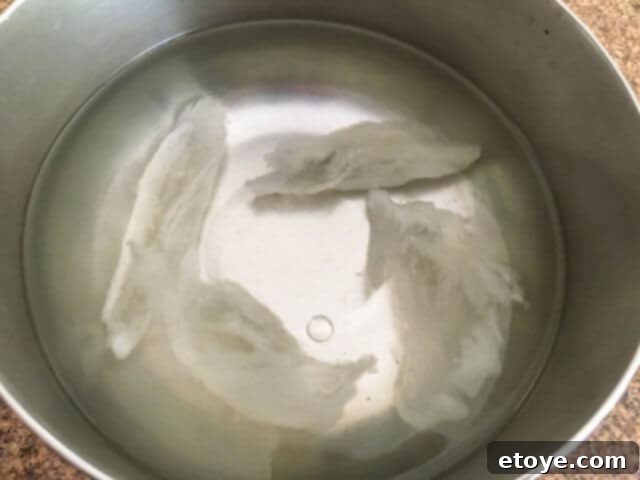
Step 2: Ensuring Purity (If Needed)
The nest should appear clean and free of all impurities. However, if your bird’s nest contains any visible feathers or debris, it’s crucial to clean it thoroughly. Bring a pot of water to a boil, add the bird’s nest, and boil for about 10 minutes. This helps to loosen any remaining impurities. Afterward, drain the nest and rinse it gently with cool water. This step is usually unnecessary for top-grade nests, which require only the initial overnight soak and drain.


Step 3: Gentle Simmering
In a clean pot, bring 6 cups of fresh water to a very low simmer. The key here is a gentle heat—you want to see only the smallest, most delicate bubbles forming, not a rolling boil. A vigorous boil would damage the delicate structure of the bird’s nest, causing it to break apart and lose its prized gelatinous texture. Once simmering, carefully add the drained bird’s nest and the dried red dates (jujubes).

Step 4: Cooking to Perfection
Continue to cook the soup on a low simmer for 30 minutes to 2 hours. The precise cooking time largely depends on the specific quality and type of bird’s nest you are using. For high-grade products, like those from Golden Nest, a mere 30 minutes of gentle simmering is often sufficient to achieve the desired soft, gelatinous texture. It is crucial not to overcook the bird’s nest, as this will result in a gummy, broken consistency, ruining the expensive delicacy. Throughout the cooking process, monitor the texture. It should become soft, gelatinous, and possess a slippery-like mouthfeel.

Step 5: Sweetening the Soup
Once the bird’s nest has reached the perfect texture, add 4 medium chunks of rock sugar to the pot. You can turn off the heat at this point and allow the residual warmth of the soup to slowly dissolve the sugar. This gentle melting process ensures an even distribution of sweetness. Taste the soup and adjust the sugar content according to your preference; the flavor should be delicately sweet, complementing the natural taste of the jujubes and the subtle essence of the bird’s nest.
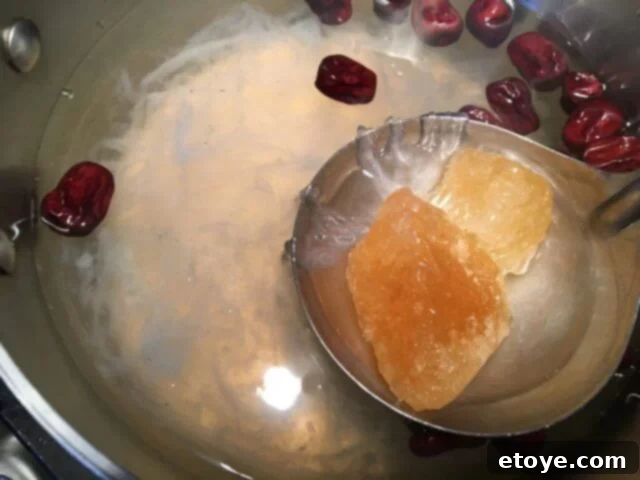
Step 6: Serve and Enjoy
Serve the Bird’s Nest Soup warm. Its delicate flavor and luxurious texture are best appreciated at this temperature, allowing all the subtle nuances to come forward. This soup is a perfect finale to a special meal or as a nourishing treat on its own.
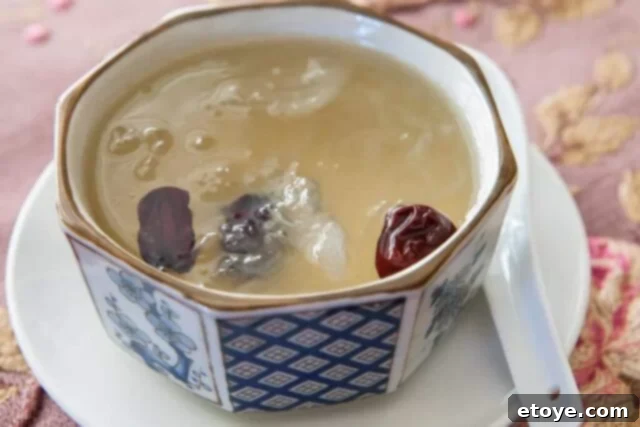
Top Tips for Perfect Bird’s Nest Soup
- Thorough Cleaning is Key: If your nest has impurities, don’t skip the extra cleaning step of boiling for 10 minutes, then draining and rinsing. This ensures a clean and pure soup.
- Gentle Simmering Only: Always maintain a very low simmer. A hard boil will break down the delicate structure of the bird’s nest, affecting its prized texture.
- Taste and Adjust Sweetness: Rock sugar provides a clean sweetness. Add gradually and taste to achieve your desired balance; the soup should be subtly sweet.
- Mind the Cooking Time: The quality of your bird’s nest dictates cooking time. Test for tenderness – it should be soft and gelatinous, not gummy.
- Serve Warm for Best Experience: The delicate flavors and unique texture are best enjoyed when the soup is served warm.
- Ethical Sourcing: Always purchase bird’s nest from reputable suppliers to ensure quality and support sustainable practices.
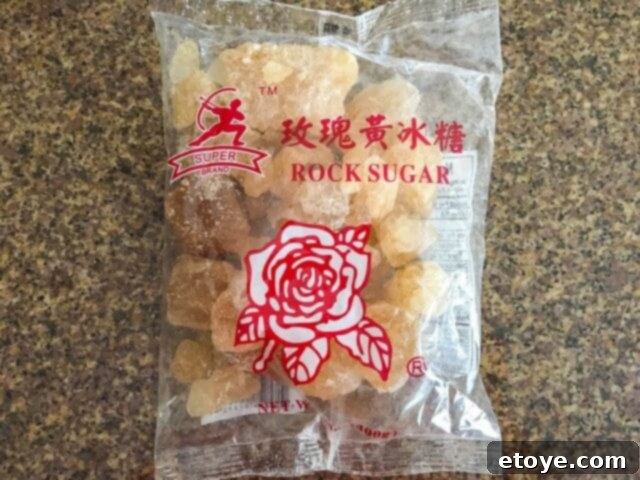
Explore Other Delicious Asian Soups
If you’ve enjoyed the refined flavors of Bird’s Nest Soup, you might also appreciate these other aromatic and comforting Asian soups:
- Thai Chicken Coconut Soup (Tom Ka Gai)
- Vietnamese Pho Recipe: Beef Noodle Soup
- 15 Minute Udon Noodle Soup with Miso
- Chinese Daikon Soup Recipe
Have you tried making this luxurious Bird’s Nest Soup? We would love to hear about your experience! Feel free to leave a star rating and share your thoughts and tips in the comments below.
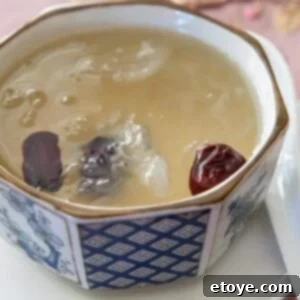
Bird’s Nest Soup
Jaden Hair
Pin Recipe
Ingredients
- Dried Red Dates
- Rock sugar
- Bird’s nest
Instructions
- Soak the bird’s nest overnight in cool water.
- Drain.
- Bring a pot with 6 cups of water to a low simmer. Add in the drained bird’s nest and jujubes.
- Keep the heat on low – you don’t want a hard, rolling boil (which would break the delicate bird’s nest). Aim for the smallest bubbles possible.
- Cook for 30 minutes – 2 hours. The timing really depends on the quality of the bird’s nest that you have. For Golden Nest’s products, it only took 30 minutes of cooking to get a gelatinous texture. If you over-cook the bird’s nest, it will become gummy and break apart, ruining the very expensive delicacy!
- Taste the bird’s nest – it should be soft, gelatinous, slippery-like.
- Add in 4 medium chunks of rock sugar. You can turn off the heat and just let the sugar slowly dissolve. Taste and add additional sugar if you’d like. The flavor should be delicately sweet.
- Serve warm.
Nutrition
Carbohydrates: 56g
Protein: 9g
Fat: 1g
Saturated Fat: 1g
Sodium: 4mg
Potassium: 169mg
Fiber: 2g
Sugar: 8g
Calcium: 14mg
Iron: 1mg
Tried this recipe?
Let us know how it was!
